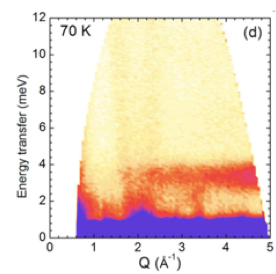F. Damay, S. Petit, S. Rols, M. Braendlein, R. Daou, E. Elkaïm, F. Fauth, F. Gascoin, C. Martin, and A. Maignan
[SciRep]
In materials science, the substructure approach consists in imagining complex materials in which a particular property is associated with a distinct structural feature, so as to combine different chosen physical characteristics, which otherwise have little chance to coexist. Applied to thermoelectric materials, it has been used to achieve simultaneously phonon-glass and electron-crystal properties. Mostly studied for its superionic conductivity, AgCrSe2 is a naturally layered compound, which achieves very low thermal conductivity, 0.4 W.K−1.m−1 at RT (room temperature), and is considered a promising thermoelectric. The Cr atoms of the [CrSe2]∞ layer bear a spin S = 3/2, which orders below TN = 55 K. Here we report low temperature inelastic neutron scattering experiments on AgCrSe2, alongside the magnetic field evolution of its thermal and electrical transport. We observe a very low frequency mode at 3 meV, ascribed to large anharmonic displacements of the Ag+ ions in the [Ag]∞ layer, and 2D magnetic fluctuations up to 3 TN in the chromium layer. The low thermal conductivity of AgCrSe2 is attributed to acoustic phonon scattering by a regular lattice of Ag+ oscillating in quasi-2D potential wells. These findings highlight a new way to achieve localised phonon modes in a perfectly crystalline solid.








